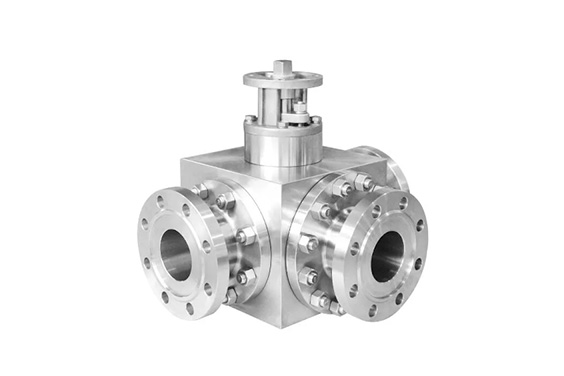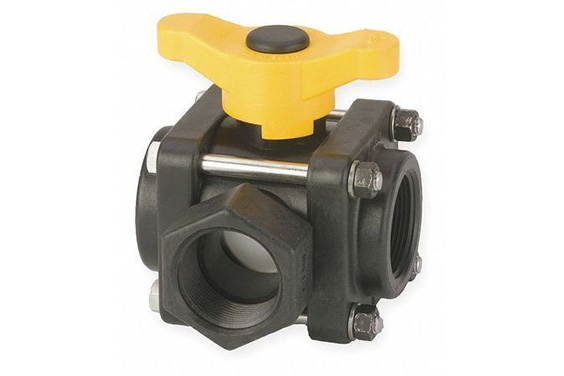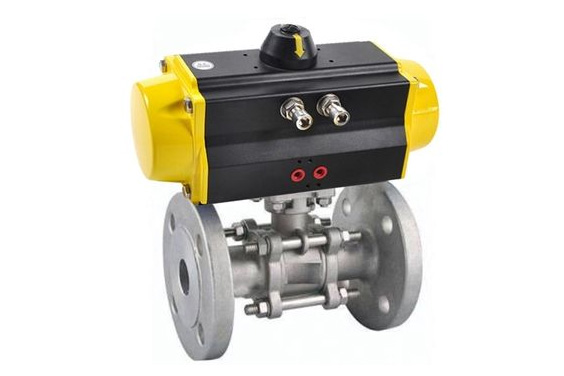3-way, also known as multiport valves, offers many resolutions for process management applications. Multiport valves are more flexible when dealing with multiple media. These 3-way valves usually confuse people who have never used them before with their functionalities.
This blog post will explain 3 way ball valve working principle and what they look like. We’ll also be discussing the various types of 3-way valves and their applications.
What Is a 3-Way Ball Valve?

A 3 way ball valve is a type of valve used to control the flow of fluids. It is a simple device that consists of a ball with three ports. The ball is rotated, so the ports align with the ports on the valve body. This allows the fluid to flow through the valve and into the appropriate outlet.
The three-way ball valve is a straightforward piece of equipment and is very easy to operate. All need to do is to turn the knob on the valve, and the ball will move into the correct position. The three-way ball valve is also effortless to maintain and does not require much maintenance. It can be used in a variety of ways. For example, it can be used to control airflow in an HVAC system, or it can be used to manage the flow of water in a plumbing system. In the food and beverage industry, the three-way ball valve controls the flow of liquids, such as milk or juice.
Types Of Three-Way Valves
Three-way ball valves are available in either the L-pattern (or the T-pattern). The working principle is the same, but the ball configuration is different.
- L-Pattern Three-Way Valves
L-pattern three-way valves are so named because of their L-shaped configuration. These valves have three ports, which are used to control the flow of fluid between two different paths. The three ports are connected through a series of passages, which can be opened or closed to control the flow of fluid.
L-pattern three-way valves are used in a variety of industries, from food and beverage processing to cosmetics manufacturing. These valves are designed to allow flow from two different inlets to a single outlet or from a single inlet to either of two outlets. L-pattern three-way valves are commonly used in applications where it is necessary to change flow direction or divert flow to another destination.
- T-Pattern Three-Way Valves
The T-pattern three-way valve is a type of valve used to control the flow of fluids. It is a valve that has three ports, two of which are connected to each other, and the third port is connected to the remaining port on the valve. The T-pattern three-way valve is used in various applications, including in plumbing and HVAC systems.
The T-Pattern 3-way valve is a specialized valve used in various industries, from manufacturing to food and beverage processing. This valve is designed to allow for the flow of two different fluids in two directions while also preventing the two fluids from mixing. This makes it an ideal choice for applications where two various fluids need to be controlled separately.
Advantages Of The 3 Way Ball Valve
The 3-way ball valve is a type of valve used in many industries. This valve is designed to control the flow of liquids and gases through a pipe. Here are five advantages of the 3-way ball valve:
- The 3-way ball valve can be used to manage the flow of liquids and gases in both directions.
- This type of valve is very reliable and can be used in high-pressure applications.
- The 3-way ball valve is easy to operate and does not require much maintenance.
- This type of valve is versatile and can be used in various applications.
- The 3-way ball valve is affordable and an excellent option for many industries.
Disadvantages Of The 3 Piece Ball Valve
While the 3-way ball valve has many advantages, there are some disadvantages to consider as well. Here are 5 of the main disadvantages of the 3-way ball valve:
- Limited sizes: 3-way ball valves are only available in a limited range of sizes. Finding the right size for a specific application can make it challenging.
- Limited flow: 3-way ball valves have a fixed flow rate due to their design. This can be an issue if needed a high flow rate for the applications.
- Limited pressure: 3-way ball valves are only rated for a certain amount of pressure. This means that they may not be suitable for high-pressure applications.
- Difficult to repair: because of their complex design, 3-way ball valves can be difficult to repair if they break. This can be a problem if want to repair the valve quickly.
- Difficult to install: 3-way ball valves can be difficult to install, especially if someone is unfamiliar with their installation process. (View more about ball valve installation)
3-Way Ball Valve Working Mechanism

This section will discuss each type of 3-way ball valve working. These are slightly different from the working of the common ball valve. The L-pattern type, or diverter valve, allows the flow change by turning the handle or actuator 90 degrees.
Suppose that the top position has the lowest port, and the left port is open. The valve will divert media flow to the correct port by turning a quarter in the clockwise direction. Another quarter bend in the other order stops the flow of media. A 270-turn would block the media flow. The valve can be returned to its initial position by turning 360 degrees. Two of the three ports can open simultaneously. This mechanism permits the ball valve to have three flow possibilities and two shutoff functions.
As the media from both channel flows can be integrated within the T-pattern, the T-pattern valve is also known as the mixer valve. The media then exits at the opposite end. All the given ports can be unlocked simultaneously.
The T-pattern ball-valve can also be used as a diverter because it can work the same way as the L-pattern. These can be done by turning the handle a quarter turn. The T-pattern can’t deliver a bubble-tight shutoff, but it can restrict the discharge to two ports or let access to all three ports.
The T-pattern ball vale can be used as a mixer to allow media to flow in two opposite directions. The T-pattern can split or allow straight flow patterns, similar to the two-way valve. The standard port for a T-pattern, a T-pattern vertically placed ball valve, is always open. Turning it one-quarter turn will cause the flow to divert. The media flow will not be affected by a 180-turn.
Locking handles are available to allow the valves to move by turning the handle. However, the locks can be rotated up 360 degrees for the 3-way valve. This is done to account for the many ports. The common entry point to the valve is usually located at the bottom.
3-Way Ball Valve vs. 2-Way Ball Valve.

In any fluid handling system, it is essential to have a valve that can control fluid flow. Many types of valves can be used for this purpose, but two of the most common are 3-way ball valves and 2-way ball valves.
So, what is the difference between these two types of valves? A 3-way ball valve has three ports, while a 2-way ball valve only has two. This means that a 3-way valve can control fluid flow in three different directions, while a 2-way valve can only control it in two.
3-way ball valves are typically used when there is a need to control fluid flow in multiple directions. For example, If valve is needed to control the flow of water to a sprinkler system, then 3-way valve is the best option to turn the water on and off in multiple directions.
2-way ball valves, on the other hand, are typically only used when there is a need to control fluid flow in two directions. For example, If valve is needed to control the water flow to a sink, then 2-way valve is best to turn the water on and off.
Bottomline
In conclusion, 3 way ball valve operation controls the flow of fluids. It consists of a ball with three ports, two of which are connected to the inlet and outlet of the valve, and the third port is connected to a drain. The ball is rotated, so the ports are aligned with the inlet and outlet, and the drain is used for flushing the valve. To learn more about different ball valve operations, visit our how does a ball valve work blog post. Contact the best industrial valves manufacturers for purchasing the reliable 3-way ball valve for all industrial uses.









